Most of the boats in this year’s Salty Dawg Rally fleet have arrived in Antigua. There are still a few underway and some had to stop elsewhere because of gear issues.
All and all, the fleet had a good run and made pretty good time in spite of a bit of a pounding due to strong winds and a tight wind angle. However, most were able to make it to Antigua with plenty of fuel to spare unlike some years when winds were light and nearly on the nose.
Astrid Deeth, of the Admiral’s Inn, in English Harbor and someone who has been really supportive of the rally from the beginning, has a home overlooking the anchorage in English Harbor and took this photo of the Dawgs at anchor when the first of the boats were arriving. This time of the season the bulk of the boats are from the rally. I’ll admit that I was quite moved when I saw this photo knowing how it feels to arrive after a long journey and wishing I was with them. 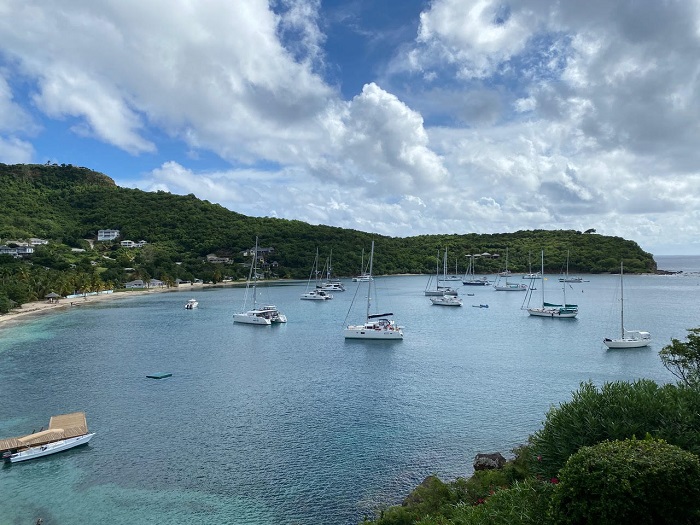 A number of boats stopped in Bermuda, one in Puerto Rico and several in the USVI, only long enough to fix stuff and lick their wounds before pulling up their shorts and heading out yet again for Antigua, their destination.
A number of boats stopped in Bermuda, one in Puerto Rico and several in the USVI, only long enough to fix stuff and lick their wounds before pulling up their shorts and heading out yet again for Antigua, their destination.
One boat stopped in Bermuda due to a crack in their crash bulkhead, left for Antigua after a few days only to be forced to turn back due to additional issues that came up. I understand that they remain determined to continue on to Antigua, in spite of everything.
The boat that stopped in the USVIs only stayed there long enough to sort out multiple issues and yesterday finally arrived in Antigua to join up with the rest of the fleet.
And yet another, that arrived overnight, will be putting their boat in a marina for a few weeks to fly back to the States to attend to the funeral of the skipper’s mother. I recall some years ago when Brenda’s mother died a few hours after I left cell range on my way south. Being as sea can be tough enough but to be separated from family under those circumstances is particularly difficult.
This is the fourth year that a destination for the rally was Antigua and it seem that this year nearly everyone “got the memo” on all that Antigua has to offer. For several years now I have been preaching that Antigua is the place to begin and end the cruising season and I am beginning to feel like word is finally getting out and it is very rewarding to see how determined skippers were in getting to the island.
It has been four years since we first decided to offer Antigua as a destination. The first year was catalyzed by the devastation that was done to the BVI by back to back hurricanes. We had a few cancelations that year but most everyone quickly switched gears and headed to Antigua.
Year two, the rally offered both the BVI and Antigua as destinations and the fleet was split, in part because the winds were particularly difficult and by the time the fleet got close to the BVI some had had enough and just decided to skip Antigua.
This year, however, seems to be different and nearly everyone who had decided on Antigua as a destination has been single minded about getting there, which has been very rewarding for me. After putting so much work into arranging more than a dozen events spread over a nearly two week period, and preaching the virtues of cruising the southeast Caribbean, I am just so pleased that the fleet headed that way.
This year preparing the fleet was the most complicated yet from an organizing standpoint, with restrictions making it impossible to have any group events in Hampton prior to departure. All participants in the rally were required to adhere to a strict quarantine protocol prior to departure and submit to a PCR virus test before even leaving the dock. It is tough enough to prepare for an offshore run but to be confined to the boat for nearly a week before leaving makes for some very complex logistics.
Rally planners met many times and communicated closely with the authorities in Antigua to establish a plan to keep skippers and crew safe and to allow for smooth clearing in process upon arrival. Our greatest fear is that one of our boats would be offshore and have someone fall ill, which would have been tragic. Happily, none did.
All of the issues of planning for a run were even more complex during the pandemic when the risk of infection are added to the sort of normal weather issues encountered on a long journey. Add to that the usual equipment and electrical issues, made the run south this year the most complex yet.
As always, stuff broke but happily there were no outbreaks of the virus on any boats, which is good news and proves that if you are careful, and take reasonable precautions, you can stay safe. I am hopeful that by the time of departure next year that everyone will have been vaccinated and things will be under control here in the US and that our run south will be more routine.
The real change this year is that it seems we are beginning to get the word out about all that Antigua has to offer. Antigua remains an underdawg (pun intended) and fact is that when sailors think about cruising in the Caribbean they think of the BVI as that’s where most if not all of them have chartered while vacationing.
The reality is that the BVI is a near perfect place to take a short holiday of a week of two, with a variety of islands to explore, all a short day sail away. It is easy enough to get up in the morning, have a leisurely breakfast, set sail and get to your destination in time for lunch. That sort of leisurely week long vacation really isn’t possible elsewhere in the Caribbean where the distances between islands is greater.
However, if you are cruiser, out for the season, the BVI does not, in my opinion, offer as much. Most businesses are focused on the one week charter trade, for whom a $50/night mooring isn’t a big deal. While they are visiting, everyone eats out most nights, spend lots of money and then fly home. Cruisers, on the other hand, spend less per day and yet spend a lot more over the course of a season. With a constant stream of vacationers booking those charters, it makes perfect sense that local businesses would focus on those who offer a more lucrative spending “per diem”.
Cruisers, in spite of the large spending over the course of a season, just can’t compete with a constant flow of high spending vacationers in the BVI who are in and out in a week or two followed by yet another group of vacationers.
Antigua, on the other hand, can’t compete for this segment of the market as it’s just not practical to charter there, especially when the strong “Christmas Winds” are up from mid December through much of January, when travel between the islands is “sporty” at best.
Additionally, many sailors just don’t know much about the southern Caribbean as the area doesn’t receive much attention from the sailing magazines. Editors and publishers know who “butters their bread” and tend to write about topics that are in line with the interests of their advertisers. And the charter companies, especially from the BVI are one of their biggest categories sothat’s what they write about.
The simple fact is that most cruisers just don’t know much about Antigua and the islands to the south so when they decide to “cast off the dock lines” the first thing that they think about is “well, we had fun when we chartered in the BVI, so let’s go there”, and they do.
It seems to me that that a lack of information about what the islands outside of the Virgins is the biggest hurdle that cruisers have needed to get over in deciding where to go. I still remember the pressure I felt from crew when we were considering where to make landfall the first year I headed south as the were pushing hard for the BVI. Getting information about St Martin and Antigua, the two spots I was considering, was very tough to find. It wasn’t until I actually showed up in Antigua that I understood why knowledgeable captains from the really big yachts chose Antigua as the island as home for the winter season.
Interestingly, this year fully two thirds of the boats in the rally are first timers at long distance ocean cruising, many more than usual, and the fact that the bulk of them chose to head to Antigua suggests that they are finally getting the message of all that Antigua has to offer. I have to give a lot of credit the rally director Sheldon for helping everyone understand that Antigua was a great place to visit and not that much farther then the Virgins. We even had a few captains that were considering other destinations only to switch to Antigua at the very last minute.
For me, after pounding that Antigua drum for years now, it has been very rewarding to see that the bulk of the fleet decided to head there and most have arrived or will be there soon.
As is nearly always the case, weather plays a big factor in where boats end up and this year is no different. As you can see from today’s tracker, there are a number of boats that are spaced along the southeast US coastline where they have ended up given the drumbeat of difficult weather that they have faced in trying to get to The Bahamas, their choice for this season. As the map shows, there are persistent NE winds, fairly typical for this time of the year, making it impossible to cross the Gulf Stream. So far, only two have made it to their destination of choice. 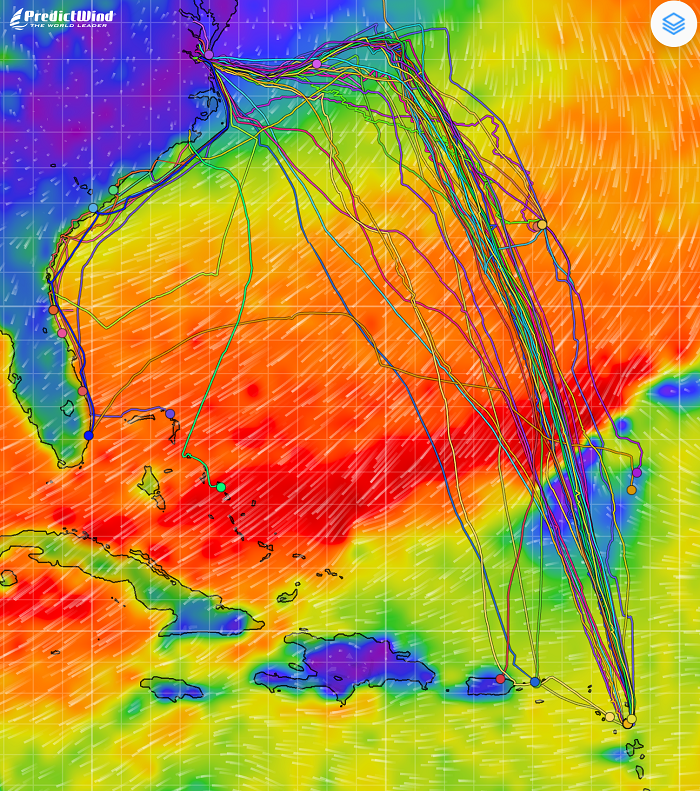 Hopefully, things will improve but the waters of the coastal US and Bahamas have been particularly hard hit by the remnants of a parade of hurricanes and tropical storms in what has been the busiest year on record.
Hopefully, things will improve but the waters of the coastal US and Bahamas have been particularly hard hit by the remnants of a parade of hurricanes and tropical storms in what has been the busiest year on record.
Arrival events in Antigua are going really well and for the first time the bulk of the fleet arrived in time to participate in the very first one. As all of the events will be held outdoors, being safe is fairly easy, with a constant flow of tropical tradewinds blowing at all times.
My friend Bill on Kalunamoo posted some very nice photos of the pool party at Boom at the Admiral’s Inn in English Harbor. It looks like it was a very nice day. 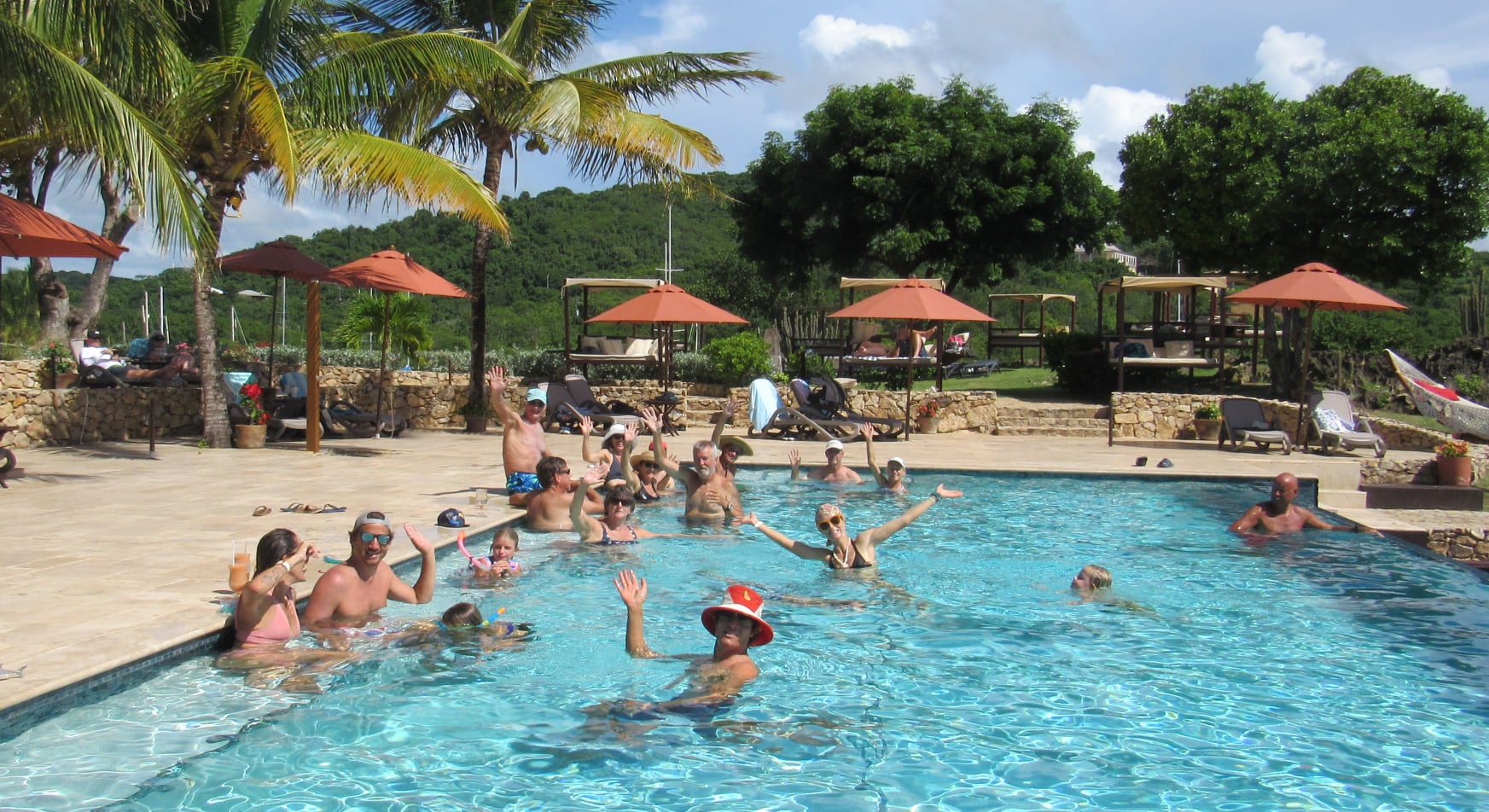 Bill’s view as he surveyed the activities and slept off lunch I expect.
Bill’s view as he surveyed the activities and slept off lunch I expect. 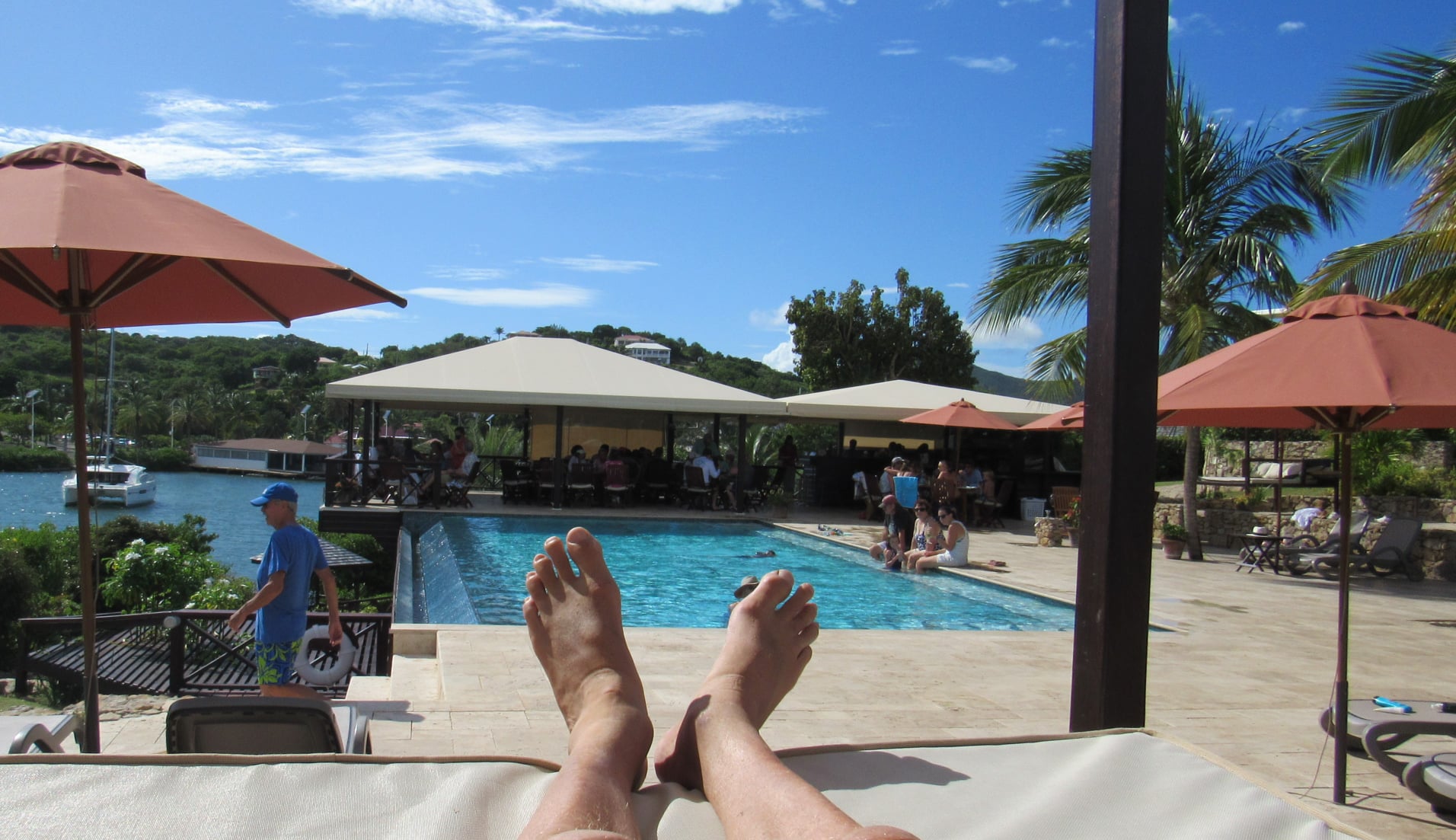 Yup, that’s Bill, the guy.
Yup, that’s Bill, the guy. 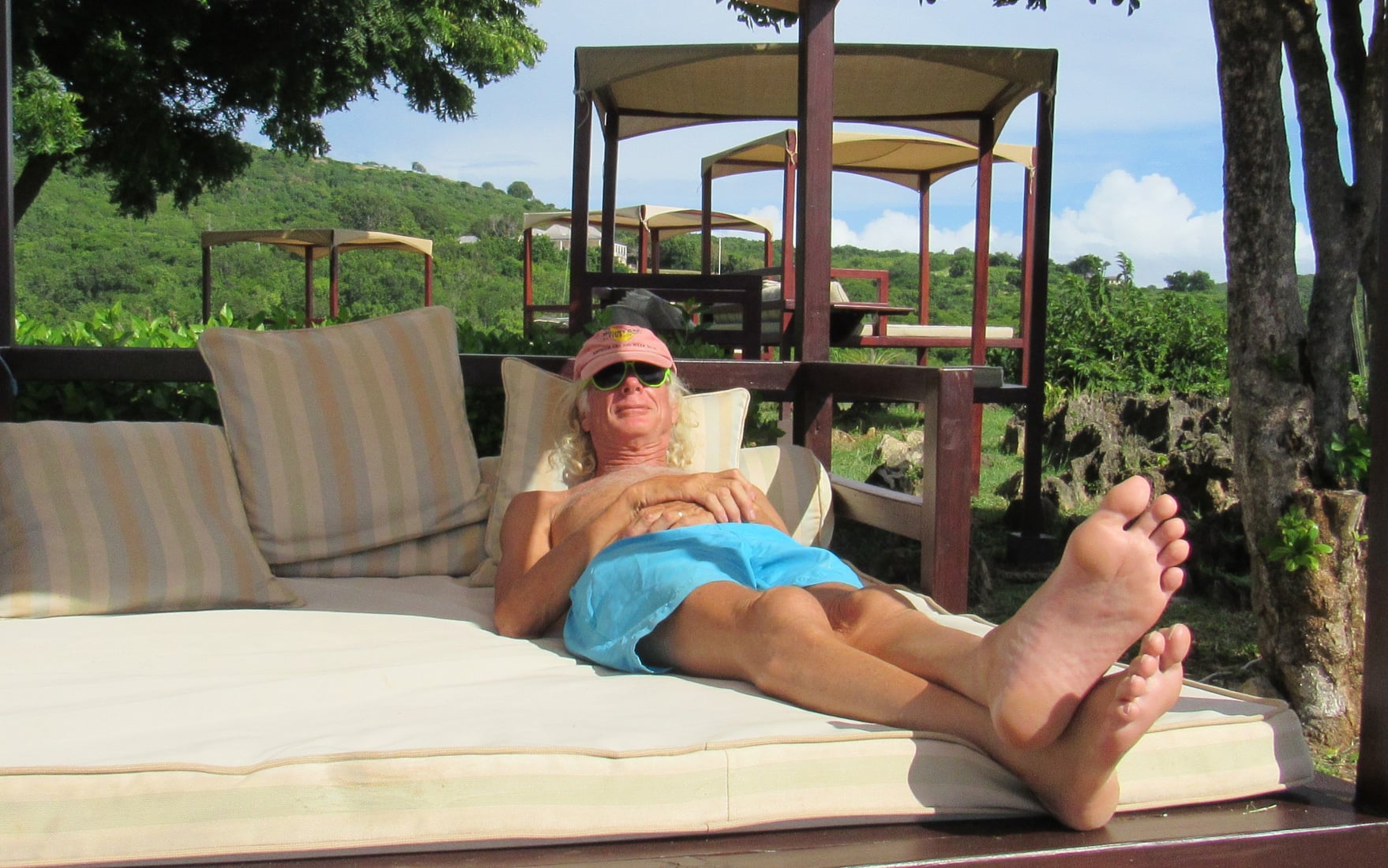 And, just to prove that all the folks in the rally aren’t as old as Bill (it takes one to know one), some younger Dawgs enjoying the day.
And, just to prove that all the folks in the rally aren’t as old as Bill (it takes one to know one), some younger Dawgs enjoying the day. 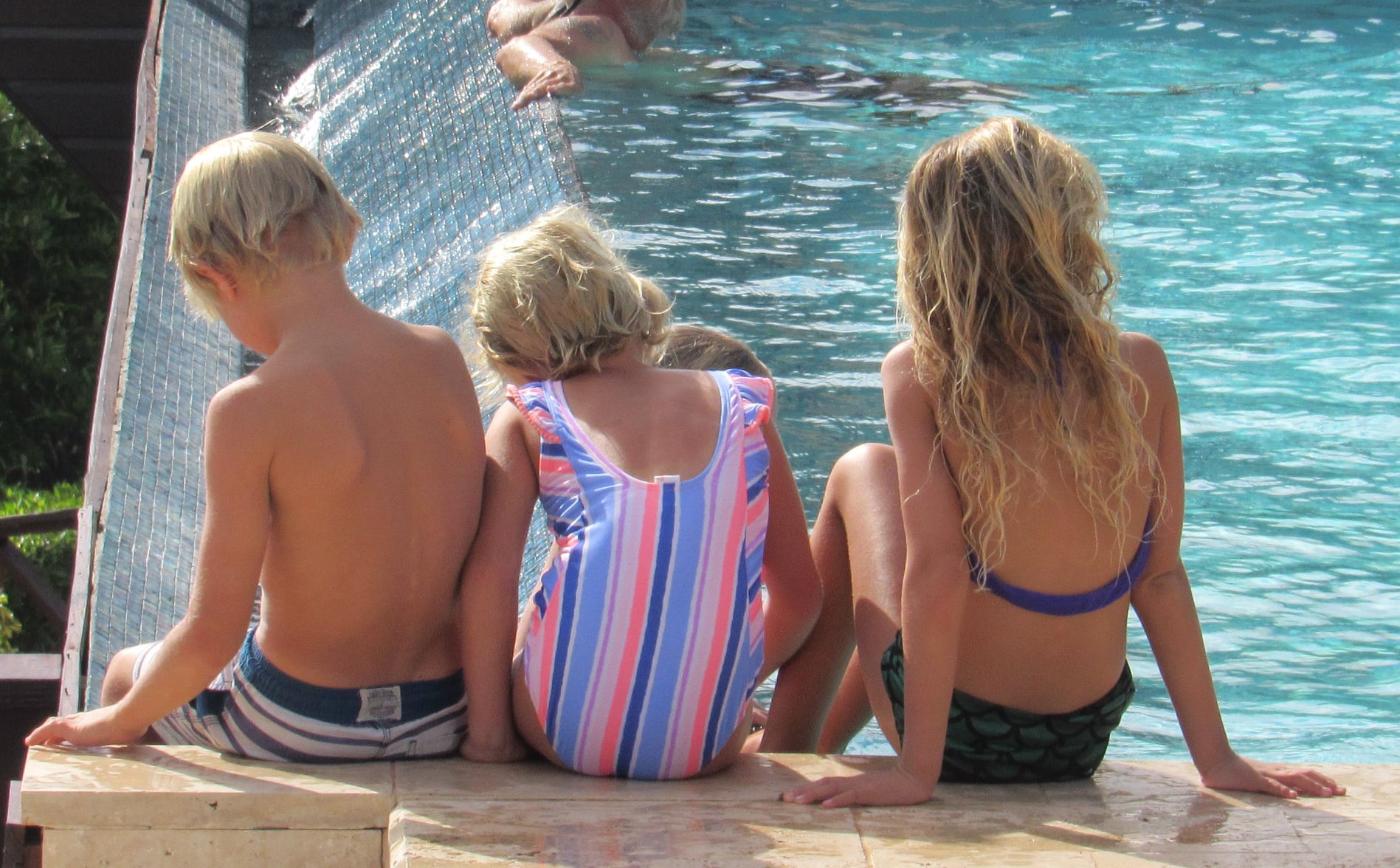 Of course, one of the key questions you have to ask yourself about is the wisdom of being in a country like Antigua, with very limited medical facilities, if you were to fall ill. When the rally was preparing for departure, everyone was very aware of the possibility of infection and the importance of staying safe. Now that they are in Antigua and likely free of infection because of their time at sea, they are once again ashore and it is possible that they will come in contact with someone who is ill. At least those who made the run are part of a large “Dawg Bubble” and probably safe.
Of course, one of the key questions you have to ask yourself about is the wisdom of being in a country like Antigua, with very limited medical facilities, if you were to fall ill. When the rally was preparing for departure, everyone was very aware of the possibility of infection and the importance of staying safe. Now that they are in Antigua and likely free of infection because of their time at sea, they are once again ashore and it is possible that they will come in contact with someone who is ill. At least those who made the run are part of a large “Dawg Bubble” and probably safe.
This is the current “dashboard” for Antigua showing the rate of infection currently on the island. There have been a very limited number of “community infections” with most coming in by air from other countries. Fortunately, the bulk have been captured shortly after landing and with good contact tracing, the virus has not been able to gain a foothold on the island.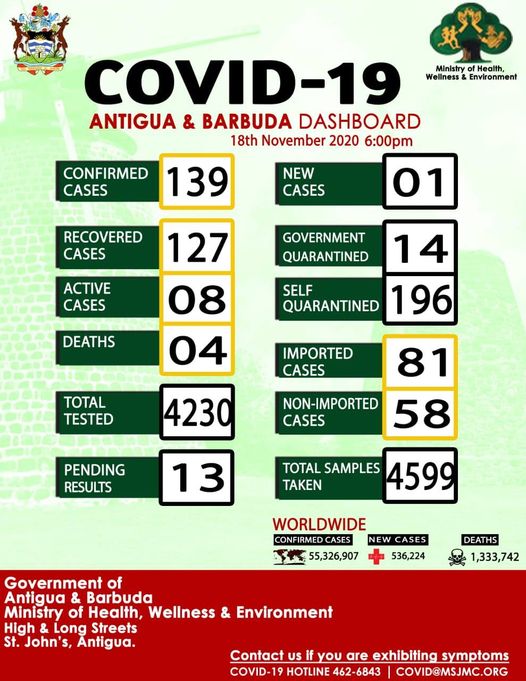 In the last two months, the number of confirmed cases has increased from 95 to 139 and there have been a total of three deaths. In spite of all that, the death rate by thousand residents is still a fraction of that in the US. As of yesterday we passed the sobering milestone of 250,00o deaths, with some experts predicting that we could log yet another 200,000 deaths before a vaccine is widely available.
In the last two months, the number of confirmed cases has increased from 95 to 139 and there have been a total of three deaths. In spite of all that, the death rate by thousand residents is still a fraction of that in the US. As of yesterday we passed the sobering milestone of 250,00o deaths, with some experts predicting that we could log yet another 200,000 deaths before a vaccine is widely available.
The question that has to be asked is if the tradeoff of a lower case load in Antigua verses better medical facilities in the US, with out of control spreading of the virus, is a good bet. I’d say that it is a tough call but the alure of warm breezes and the ability to do most everything outdoors is sure appealing to me.
Only time will tell which is the best approach but when I got up this morning and saw that it was 20 degrees out, I have to say that sitting by the pool in English Harbor seemed mighty appealing.
In spite of my obvious self-pity, it is rewarding to know that the Salty Dawg fleet is now in Antigua and are having a good time.
As jealous as that makes me, at least I can take solace in knowing that the weather will get better in May. That’s me, ever hopeful.


 And, when it comes to crew, the bulk of boats in the rally take on extra hands for the run. Remarkably, Iain on Fatjax, a go-fast carbon flyer, made his run as a single hander and arrived only a week after leaving Hampton, a remarkable accomplishment. I caught up with Iain earlier today on a call and learned more about him and Fatjax. I’ll be sharing what we talked about in a few days so stay tuned. For now, here’s a shot of Fatjax anchored in English Harbor awaiting clearance.
And, when it comes to crew, the bulk of boats in the rally take on extra hands for the run. Remarkably, Iain on Fatjax, a go-fast carbon flyer, made his run as a single hander and arrived only a week after leaving Hampton, a remarkable accomplishment. I caught up with Iain earlier today on a call and learned more about him and Fatjax. I’ll be sharing what we talked about in a few days so stay tuned. For now, here’s a shot of Fatjax anchored in English Harbor awaiting clearance. 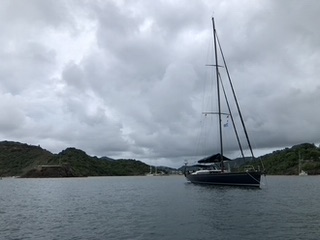 Ocean voyaging is a big deal and to sail alone around the world, like the boats competing in the Vendee Globe, especially without stopping, is a very big deal.
Ocean voyaging is a big deal and to sail alone around the world, like the boats competing in the Vendee Globe, especially without stopping, is a very big deal.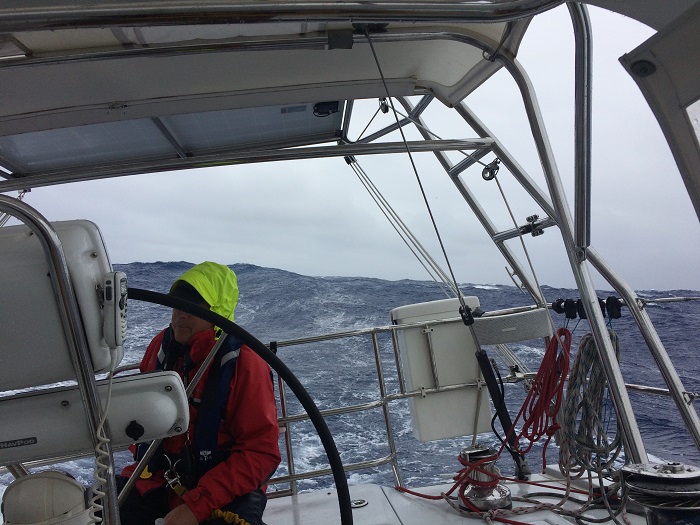 The autopilot steered the boat very well but ultimately a linkage failed and while someone was able to take control quickly, but before things were under control, we slewed nearly broadside to the waves. It was a very hairy moment, and one that I don’t want to repeat. I was able to repair the broken linkage but it took several hours and after the failure, we really didn’t trust my fix and someone stood at the helm every moment for the rest of the trip. It turns out that the prior owner had experienced this exact same failure multiple times over the years. Great to hear, after the fact. I was determined to avoid a repeat and
The autopilot steered the boat very well but ultimately a linkage failed and while someone was able to take control quickly, but before things were under control, we slewed nearly broadside to the waves. It was a very hairy moment, and one that I don’t want to repeat. I was able to repair the broken linkage but it took several hours and after the failure, we really didn’t trust my fix and someone stood at the helm every moment for the rest of the trip. It turns out that the prior owner had experienced this exact same failure multiple times over the years. Great to hear, after the fact. I was determined to avoid a repeat and 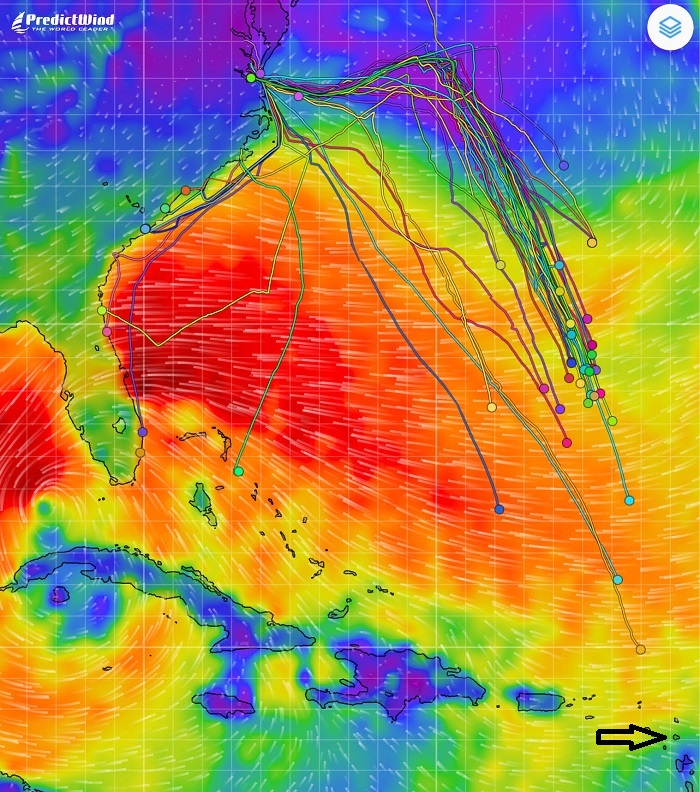 To see the fleet in real time, and see how this all plays out, click here to go to the
To see the fleet in real time, and see how this all plays out, click here to go to the 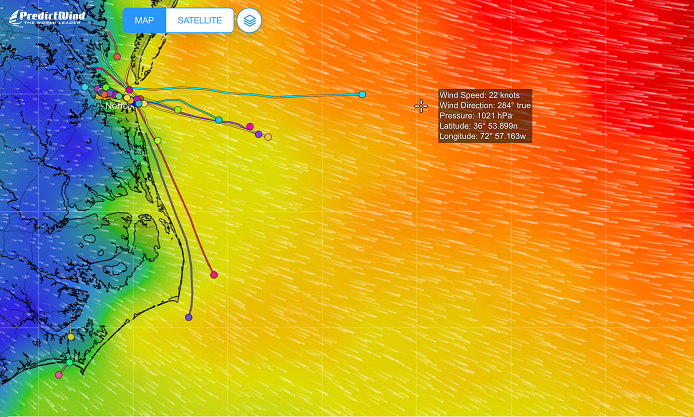 And, there is a lot going on weather-wise, with yet another late season hurricane off of Honduras. The blue areas have light wind and dark red, lots…
And, there is a lot going on weather-wise, with yet another late season hurricane off of Honduras. The blue areas have light wind and dark red, lots…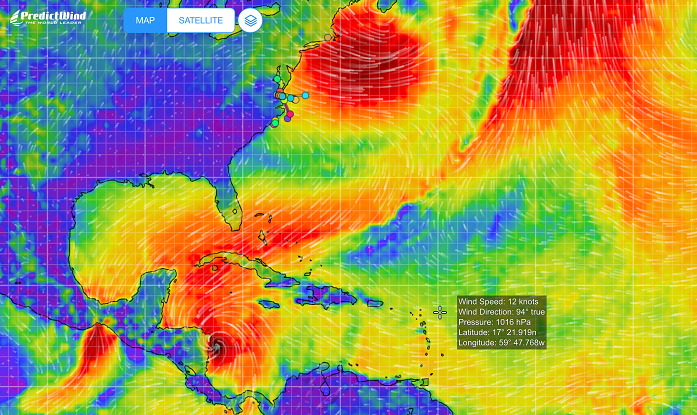 I hope to be able to provide more commentary in the coming days and will follow weather alerts from Chris to share what I can regarding the conditions that the fleet is experiencing along the way. I clipped these images from my iPad but they don’t offer as much functionality as you will get on a PC, where there is a list of individual boats along the border so you can more easily see who is who.
I hope to be able to provide more commentary in the coming days and will follow weather alerts from Chris to share what I can regarding the conditions that the fleet is experiencing along the way. I clipped these images from my iPad but they don’t offer as much functionality as you will get on a PC, where there is a list of individual boats along the border so you can more easily see who is who.